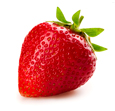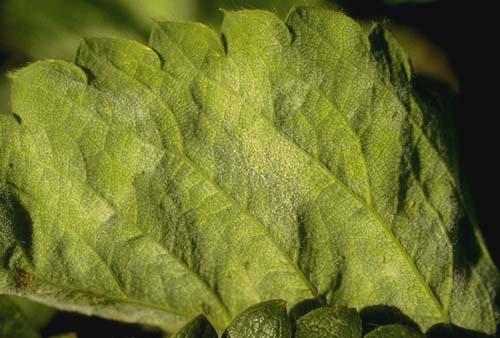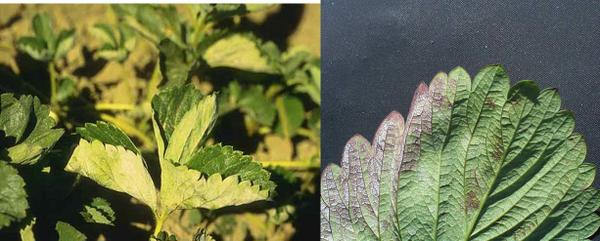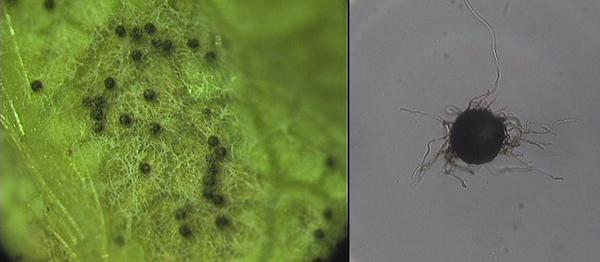Powdery Mildew
- Scientific Name(s)
- Podosphaera aphanis
- Type
- Disease
- Leaf Location
- Upper surface, Underside, Young
- Fruit Condition
- Deformed, Lesion
- Field Distribution
- Random, Localized
- Prior Environmental
- Dry, High temperature, Temp. between 20° and 32°
- Season
- Post transplant, Harvest
- Cropping System
- Annual plasticulture, Perennial matted row
Introduction
Powdery mildew is usually not a problem on strawberries in annual production systems. The pathogen may come in with northern grown transplants but disease progress does not continue once transplanted into fruiting fields. Powdery Mildew may occur on strawberry fruit under favorable circumstances. Powdery mildew can become a problem in high tunnel or matted row production.
Symptoms and Signs
The first symptom seen is usually the curling up of leaf margins, exposing the white patches of mycelium on the lower leaf surface. The patches may eventually coalesce to cover the entire underside of the leaf. Magnification may be required to see this, as powdery mildew on strawberry leaves is not as obvious as on other plants. Infected leaves may curl and purple and reddish blotches can also appear on the lower leaf surface (Figure SS-2), also, numerous black specks (cleistothecia; also called chasmothecia) may be observed (Figure SS-3). Flowers, petioles, and fruit also can become infected. Economic loss may result from fruit infection. Infected berries will have a dull sheen and mycelium is visible using a 20 to 30x hand lens. In severe cases, fruit may become cracked and have a tan to rusty-pink appearance. Heavy powdery mildew infection may result in a serious reduction in photosynthesis, affecting overall plant vigor, fruit production, and quality.
Disease Cycle
The fungus cannot survive in the absence of living host tissue, and therefore the source of inoculum must either overwinter on infected live strawberry leaves or be brought in on transplants. Cleistothecia may act as a viable source of inoculum releasing ascopores to cause initial infections. Once established, development and spread of conidia from infected leaves occurs in windy conditions during moderate to high humidity and temperatures between 60-80°F (15-27°C). Infection and germination do not require free water. Warm temperatures with high humidity in the strawberry canopy favors powdery mildew growth on fruit. Disease is favored in summers in northern production regions in nurseries and high tunnels systems in the south.
Management
Cultural
Choose a site with good sun exposure and minimal shade. The cultivar Titan is the most susceptible cultivar in North Carolina in matted row systems. Fruit infection can occur on any cultivar if the fungus is allowed to build up on Titan plants nearby. There are no known differences in susceptibility in annual varieties. Monitor the field for the first signs of powdery mildew--leaf distortion and discoloration. If disease is detected, determine whether a fungicide spray program is necessary. Likewise, monitor in the spring for the dull sheen on mature fruit due to mildew growth.
Chemical Control
Fungicide sprays are rarely needed for powdery mildew control in North Carolina annual production systems. Protectant and/or systemic fungicides can be initiated when concerning levels of symptoms are observed. Very good products are available and products, rates and timing are highlighted in our Strawberry IPM Guide.
Pathogen
Powdery mildew Podosphaera aphanis (syn. Sphaerotheca macularis); Sphaerotheca macularis (Wallr.:Fr.) Jacz. F. sp. fragariae Peries)
Podosphaera aphanis is an obligate, biotrophic fungus that causes damage to strawberry leaves, flowers, and fruit. Unlike most fungal pathogens, P. aphanis grows epiphytically on plants, producing hyphae on the lower leaf surface and on the surfaces of flowers and fruit. P. aphanis forms ellipsoidal to barrel-shaped, hyaline conidia in true chains (Heffer et al., 2006). Conidia typically measure 31.2 μm ± 2.8 × 20.39 μm ± 4.1 (Santos et al., 2002).
P. aphanis is heterothallic, meaning two compatible mating types are required for sexual reproduction. Chasmothecia, dark round structures resulting from sexual fusion (Figure SS-3), contain a single ascus, which contains eight (sometimes six) uninucleate ascospores. The appendages of the chasmothecia are simple and hypha-like (Gadoury et al.; Heffer et al., 2006).
Diagnostic Procedures
Signs of powdery mildew may be confused with white waxy residue associated with whitefly eggs. Examination under magnification will differentiate between the two by the presence of hyphae and fungal structures.
A simple method for making a slide to confirm a powdery mildew diagnosis can be conducted using a small piece of clear tape. Hold one end of the tape and lightly smooth the rest of the tape over the infected leaf surface. Remove the tape from the leaf and place it sticky side down on a drop of water on a microscope slide. If fruiting structures are absent on affected sample, individual leaves or leaflets may be incubated in a moist chamber for 24 to 48 hours to induce sporulation.
In heterothallic ascomycetes, including P. aphanis, mating occurs only between isolates with the MAT1-1 and MAT1-2 idiomorphs. PCR-based markers have been developed from these mating type genes which can be used to determine the mating type of P. aphanis (Asalf et al., 2013).
References
Asalf, B., Gadoury, D. M., Tronsmo, A. M., Seem, R. C., Cadle-Davidson, L., Brewer, M. T., and Stensvand, A. 2013. Temperature regulates the initiation of chasmothecia in powdery mildew of strawberry. Phyto-pathology 103:717-724.
Gadoury, D. M., Asalf, B., Heidenreich, M. C., Herrero, M. L., Welser, M. J., Seem, R. C., Tronsmo, A. M., and Stensvand, A. 2010. Initiation, development, and survival of cleistothecia of Podosphaera aphanis and their role in the epidemiology of strawberry powdery mildew. Phytopathology 100: 246-251.
Heffer, V., Johnson, K. B., Powelson, M. L., Shishkoff, N. 2006. Identification of powdery mildew fungi. The Plant Health Instructor. DOI:10.1094/PHI-I-2006-0706-01
Maas, J. L. 1998. Compendium of Strawberry Diseases, 2nd edition. APS Press. St. Paul, MN.
Santos, B., Blanco, C., Porras, M., Barrau, C., Romero, F. 2002. First Confirmation of Sphaerotheca macularis on Strawberry Plants in Southwestern Spain. Plant Disease, 86(9): 1049.








